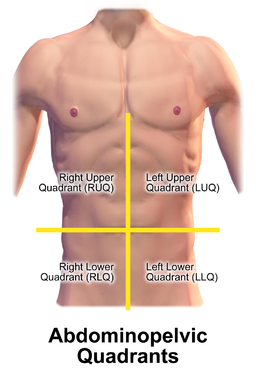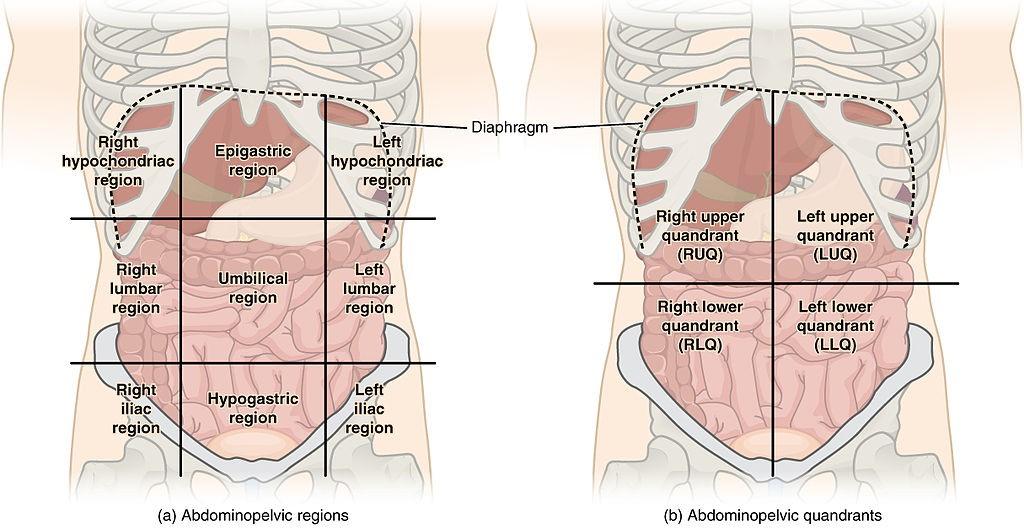Right lower quadrant pain
Peer reviewed by Dr Rachel Hudson, MRCGPLast updated by Dr Caroline Wiggins, MRCGP Last updated 15 Oct 2024
Meets Patient’s editorial guidelines
- DownloadDownload
- Share
- Language
- Discussion
Right lower quadrant (RLQ) pain is tummy (abdominal) pain that is mainly in the lower half on the right-hand side. It is sometimes also called right iliac fossa (RIF) pain, although this really means pain in a smaller area in the lower right corner of your tummy.
In this article:
Continue reading below
Where is my right lower quadrant?
The right lower quadrant (RLQ) is a section of your tummy (abdomen). Look down at your tummy, and mentally divide the area from the bottom of your ribs down to your pubic hair into four quarters. The quarter on your right side below your belly button is your RLQ.
Abdominopelvic Quadrants

By Blausen.com staff (2014). “Blausen Medical 2014”. WikiJournal of Medicine 1 (2). DOI:10.15347/wjm/2014.010. ISSN 2002-4436.
What is in my right lower quadrant?
Abdominal Quadrant Regions

OpenStax, CC BY 3.0, via Wikimedia Commons
Small bowel (ileum).
The connection between your small bowel and your large bowel (caecum).
Appendix.
First part of your large bowel (colon).
Right ureter (at the back of the other organs).
Right ovary and Fallopian tube.
And don't forget the skin, muscles and nerves of that area.
Continue reading below
Common causes of right lower quadrant pain
The list of causes of right lower quadrant pain is extremely long but the following are some of the more common possibilities (they are not in order of how common they are):
Constipation
If your guts are full of poo (faeces) this can cause discomfort anywhere in your tummy.
You will normally be aware that you are not opening your bowels as often as usual.
Your poo will be hard and pellet-like.
See the separate leaflet called Constipation for more information.
Gastroenteritis and food poisoning
These conditions can cause diarrhoea.
They may also make you sick (vomit).
Pain may be anywhere in the abdomen (tummy).
Pain may ease for a while each time some diarrhoea is passed.
See the separate leaflets called Gastroenteritis and Food poisoning for more information.
Irritable bowel syndrome (IBS)
This is very common.
It tends to cause crampy tummy (abdominal) pains.
It often causes bloating.
It comes and goes and may be associated with diarrhoea and/or constipation.
See the separate leaflet called Irritable bowel syndrome for more information.
Appendicitis
Usually the pain starts in the middle of the tummy over the period of an hour or so.
Typically it moves to the RLQ over the next few hours.
It tends to be sharper if you cough or move suddenly.
It may ease a bit if you pull your knees up to your chest.
You may also feel sick (nausea) and go off your food. You may vomit.
You may have a temperature (fever) and will feel generally unwell.
If the appendix bursts then pain can be severe and all over your tummy.
See the separate leaflet called Appendicitis for more information.
Diverticulitis
This is an inflammation of a pouch or pouches which people who have diverticular disease have in their guts.
Usually pain from diverticular disease is in the left lower quadrant (LLQ) but it can be on the right or sometimes can be felt higher up.
It usually comes with a temperature and a change in bowel habit (opening your bowels more or less often than usual for you).
Trapped inguinal or femoral hernia
A right inguinal or femoral hernia happens when a piece of bowel or other tissue from inside the tummy pushes through a weakness in the muscles of the tummy wall near the right groin.
It can happen on either side.
If whatever has pushed through gets stuck and can't slide back inside the tummy, it is trapped (incarcerated).
If it happens on the right-hand side, there will be a tender swelling in the right groin.
It causes pain in the groin and in the tummy, usually on the side of the hernia but it may cause pain over the whole tummy.
It is common to be sick (vomit).
See the separate leaflet called Hernia for more information.
Can kidney infection cause right lower quadrant pain?
A kidney infection can cause pain anywhere along your urinary tract. So this could be anywhere from the loin in your back, around the side and down to the right lower quadrant. It would be unusual to have pain just in the right lower quadrant, more common for it to also be in the right loin/right upper quadrant.
You may notice that it hurts when you pass urine and that you need to pass urine more often. You may also have a temperature or feel shivery.
See the separate leaflet called Kidney infection (Pyelonephritis) for more information.
Continue reading below
Causes of right lower quadrant pain in women
Mittelschmerz
This is pain when you release an egg (ovulation), which is usually about halfway between two periods.
It can be very severe and stop you short but usually eases over several minutes.
It will only be felt on one side but can be right or left. You may get similar pain on the same or other side of your tummy at the same point in another cycle.
Pelvic inflammatory disease
Pain is usually on both sides but may just be in the RLQ.
Pain is worse during sex.
There is abnormal bleeding, so bleeding not just at period time but in between periods and often after sex.
You may feel generally unwell and feverish.
There is usually a vaginal discharge, which may be smelly.
See the separate leaflet called Pelvic inflammatory disease for more information.
Twisted ovary
Twisted ovary (ovarian torsion) usually only occurs if a fluid-filled sac (cyst) has developed on the right ovary.
Pain can be constant or intermittent.
Symptoms can be similar to appendicitis.
See the separate leaflet called Ovarian cyst for more information.
Endometriosis
Sometimes endometriosis can cause constant lower tummy pain, although usually it is worse just before, during and for a short while after a period.
Pain is usually across the lower part of the tummy but it can be just on the right side.
See the separate leaflet called Endometriosis for more information.
Ectopic pregnancy
You should always see a doctor urgently if there is any chance that you may be pregnant and are experiencing right lower quadrant pain. You could have an ectopic pregnancy
.
Causes of right lower quadrant pain in men
Any pain coming from the right side of the scrotum can cause pain in the RLQ but usually the pain in the scrotum will be worse.
Torsion of the testicle
Torsion of the testicle (testis) causes severe pain in the scrotum and severe lower quadrant pain, usually on one side.
It most commonly affects teenage boys but young adult men can be affected.
It is unusual over the age of 25 years but can affect any man at any age.
The testicle is very tender.
You should seek urgent medical advice.
See the separate leaflet called Testicular torsion for more information.
Epididymo-orchitis
Epididymo-orchitis is an inflammation of the testicle and/or the tubes surrounding it (epididymis).
It is caused by a germ (infection).
The affected side of the scrotum swells and goes very red and tender.
See the separate leaflet called Epididymo-orchitis for more information.
Other possible causes of right lower quadrant pain
Inflammatory bowel disease
Crohn's disease and ulcerative colitis are forms of inflammatory bowel disease (IBD). IBD is not to be confused with irritable bowel syndrome (IBS) which is very different. These conditions cause the lining of the gut to become inflamed. Diarrhoea (sometimes with blood mixed in) is usually the main symptom.
Crohn's disease
Any part of the gut can be affected and the pain depends on which part is affected.
The most common place for it to start is at the end of the small intestine (ileum) causing RLQ pain.
This is where the appendix is and the symptoms can be very like appendicitis.
See the separate leaflet called Crohn's disease for more information.
Ulcerative colitis
Diarrhoea is often mixed with mucus or pus.
Blood mixed with the diarrhoea is common.
The tummy (abdominal) pain is typically crampy.
See the separate leaflet called Ulcerative colitis for more information.
Colon cancer
Colon cancer is one of the most common cancers in the UK (in contrast, cancer of the small intestine is rare).
Although it can affect any part of the large bowel (colon), it commonly affects the last part (descending colon) which is on the left-hand side.
Pain is more likely to be in the left lower quadrant (LLQ) than the RLQ.
There is usually a change in how often you need to open your bowels and you may notice that you have lost weight, without trying.
See the separate leaflet called Bowel cancer (Colorectal cancer) for more information.
Kidney stones
Kidney stones are hard stones that can form in the kidney, in the tube (the ureter) draining urine from the kidney, or in the bladder.
A stone that passes into the ureter draining urine from your right kidney may cause pain that starts in your right loin and spreads (radiates) to your groin and RLQ, or into your testicle (testis) or penis if you are a man.
You may notice blood in your urine.
See the separate leaflet called Kidney stones for more information.
Shingles
In some cases you may have pain from shingles before a blistery rash appears.
Pain tends to be sharp or burning.
You may not feel quite yourself.
The tummy (abdomen) is a common place for shingles rash.
See the separate leaflet called Shingles (Herpes Zoster) for more information.
Abdominal aortic aneurysm
An abdominal aortic aneurysm is a swelling of the largest blood vessel in the body (the aorta) inside the abdomen.
It doesn't usually cause any symptoms but can occasionally cause pain before it bursts. The pain is usually felt in your back or the side of your tummy (abdomen) but it can occasionally be felt in the right (or left) lower quadrant.
See the separate leaflet called Abdominal aortic aneurysm for more information.
What else could it be?
These lists of possible causes for RLQ are by no means exhaustive and there are many other conditions that can cause pain in the RLQ. Problems in your spine or back could be 'referred'. Referred pain in this situation means that it is coming from your back but you feel the pain around the front of your body.
Muscular pulls and sprains can also affect you in the tummy area. If this is the case, moving the particular muscle would make the pain worse, whereas if you were to lie completely still, it wouldn't hurt.
When to see a doctor
If you have a pain which doesn't settle, you will probably need to see a health professional to help you figure out the cause. See a doctor urgently if you:
Have very severe pain.
Have persistent sickness (vomiting).
Have recently lost weight without trying to do so.
Have persistent diarrhoea.
Feel giddy, light-headed, faint or breathless.
Are bringing up blood or have blood in your poo (faeces).
Have a change from your usual bowel habit. This means you may open your bowels more or less often than usual, causing bouts of diarrhoea or constipation.
Could be pregnant.
How is right lower quadrant pain diagnosed?
Your doctor will narrow the (enormous) field of possible RLQ pain diagnoses by talking with you and examining you. They may be able to find the cause simply by doing so. For example, if they find the typical rash of shingles, you will need no further tests to find the cause.
The doctor will certainly need to feel your tummy (abdomen) in the area you have the pain, but may also need to examine other parts too, such as the rest of your tummy. You will probably be asked to provide a sample of urine, to rule out kidney problems.
You may well have to go for blood tests. These might include tests to:
Check the function of your liver and kidneys.
Rule out any inflammation or infection in your body.
Look for anaemia.
Check your sugar level.
What other tests might be needed for right lower quadrant pain?
Next it will depend on what the examination and the tests above have suggested. In some cases no further tests will be needed - if, for example, your doctor is confident you have constipation or shingles.
If a problem with your large bowel is suspected, you may need an examination with a tube with a camera put into your large bowel (a colonoscopy). A computerised tomography (CT) scan or an ultrasound scan may be helpful to look for diverticula and to look at your kidneys.
These tests are also used in women to look at the ovary and tubes. In some cases an X-ray of the tummy may be useful. Further tests include other 'scopes' (such as a sigmoidoscopy) and other scans (such as a magnetic resonance imaging (MRI) scan).
If it is thought you have appendicitis, an ectopic pregnancy (women) or a torsion of your testicle (testis) - men, you may only have one or two of these tests before having emergency surgery to treat your problem.
Nobody will need all these tests, and some people may not need any.
How to treat right lower quadrant pain
There is no single answer to this until you know what the cause of your pain is. See the relevant leaflet for the condition with which you have been diagnosed. Treatments for a few of the causes of RLQ pain are briefly discussed below.
Constipation can be treated with medicines, but often changes to your diet are needed to prevent it happening again.
Gastroenteritis usually doesn't need any treatment, other than drinking plenty of fluid to compensate for all that is being lost. Occasionally when germs (bacteria) which can be treated with antibiotics are causing the infection, an antibiotic may help.
Appendicitis may be treated with an operation (an appendicectomy).
Ectopic pregnancy is usually treated by an operation but medical treatment is now more common. This avoids the need for surgery and means the tube is less likely to be permanently damaged.
Shingles. The pain and rash settle on their own in time, but some people may be advised to take an antiviral tablet to reduce the risk of long-term nerve pain from the shingles.
Kidney infections are treated with antibiotics. Mild infections can be treated with antibiotics at home. If you are very unwell you may need admission to hospital for antibiotics and fluids through a drip (intravenously).
Kidney stones. Small kidney stones pass on their own eventually, in which case you will need to drink plenty of fluids and take strong painkillers. Larger kidney stones may need one of a number of procedures done to break them up or remove them altogether.
What is the outlook?
Again this depends entirely on the cause of the pain. Some conditions settle very quickly on their own (for example, gastroenteritis), or with the help of antibiotics (for example, a kidney infection).
Others can be cured with surgery, such as appendicitis or torsion of the testicle (testis). Some are long-term conditions, for which there is no cure although there are treatments, such those used for people who have Crohn's disease. Your doctor should be able to give you an idea of the outlook (prognosis) once a diagnosis has become clear.
Patient picks for Abdominal pain

Digestive health
Mesenteric adenitis
Mesenteric adenitis means swollen (inflamed) lymph glands in the tummy (abdomen), which causes tummy pain. It is sometimes called mesenteric lymphadenitis. The mesentery is the part of the tummy where the glands are located. Adenitis means inflamed lymph glands.
by Dr Doug McKechnie, MRCGP

Digestive health
Spleen pain
This leaflet gives a brief overview of the spleen and its functions.
by Dr Colin Tidy, MRCGP
Further reading and references
- Cartwright SL, Knudson MP; Evaluation of acute abdominal pain in adults. Am Fam Physician. 2008 Apr 1;77(7):971-8.
- Cartwright SL, Knudson MP; Diagnostic imaging of acute abdominal pain in adults. Am Fam Physician. 2015 Apr 1;91(7):452-9.
- Suspected cancer: recognition and referral; NICE guideline (2015 - last updated May 2025)
Continue reading below
Article history
The information on this page is written and peer reviewed by qualified clinicians.
Next review due: 14 Oct 2027
15 Oct 2024 | Latest version
Last updated by
Dr Caroline Wiggins, MRCGP
Peer reviewed by
Dr Rachel Hudson, MRCGP

Ask, share, connect.
Browse discussions, ask questions, and share experiences across hundreds of health topics.

Feeling unwell?
Assess your symptoms online for free
Sign up to the Patient newsletter
Your weekly dose of clear, trustworthy health advice - written to help you feel informed, confident and in control.
By subscribing you accept our Privacy Policy. You can unsubscribe at any time. We never sell your data.